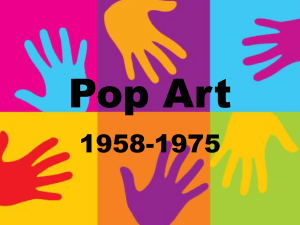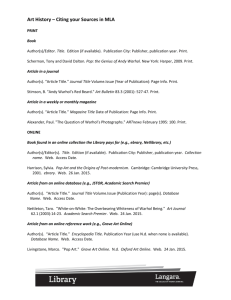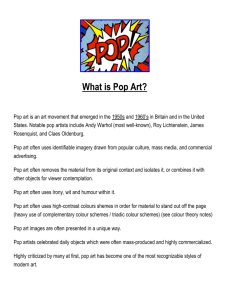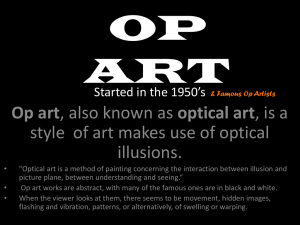Details of Renaissance Paintings
advertisement
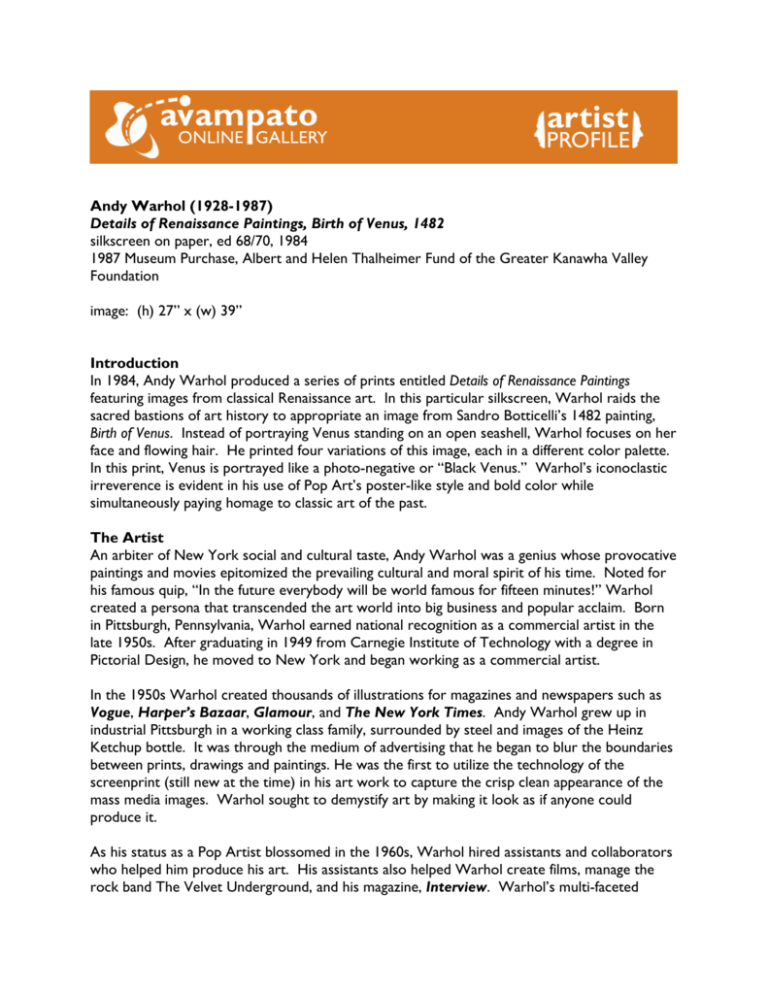
Andy Warhol (1928-1987) Details of Renaissance Paintings, Birth of Venus, 1482 silkscreen on paper, ed 68/70, 1984 1987 Museum Purchase, Albert and Helen Thalheimer Fund of the Greater Kanawha Valley Foundation image: (h) 27” x (w) 39” Introduction In 1984, Andy Warhol produced a series of prints entitled Details of Renaissance Paintings featuring images from classical Renaissance art. In this particular silkscreen, Warhol raids the sacred bastions of art history to appropriate an image from Sandro Botticelli’s 1482 painting, Birth of Venus. Instead of portraying Venus standing on an open seashell, Warhol focuses on her face and flowing hair. He printed four variations of this image, each in a different color palette. In this print, Venus is portrayed like a photo-negative or “Black Venus.” Warhol’s iconoclastic irreverence is evident in his use of Pop Art’s poster-like style and bold color while simultaneously paying homage to classic art of the past. The Artist An arbiter of New York social and cultural taste, Andy Warhol was a genius whose provocative paintings and movies epitomized the prevailing cultural and moral spirit of his time. Noted for his famous quip, “In the future everybody will be world famous for fifteen minutes!” Warhol created a persona that transcended the art world into big business and popular acclaim. Born in Pittsburgh, Pennsylvania, Warhol earned national recognition as a commercial artist in the late 1950s. After graduating in 1949 from Carnegie Institute of Technology with a degree in Pictorial Design, he moved to New York and began working as a commercial artist. In the 1950s Warhol created thousands of illustrations for magazines and newspapers such as Vogue, Harper’s Bazaar, Glamour, and The New York Times. Andy Warhol grew up in industrial Pittsburgh in a working class family, surrounded by steel and images of the Heinz Ketchup bottle. It was through the medium of advertising that he began to blur the boundaries between prints, drawings and paintings. He was the first to utilize the technology of the screenprint (still new at the time) in his art work to capture the crisp clean appearance of the mass media images. Warhol sought to demystify art by making it look as if anyone could produce it. As his status as a Pop Artist blossomed in the 1960s, Warhol hired assistants and collaborators who helped him produce his art. His assistants also helped Warhol create films, manage the rock band The Velvet Underground, and his magazine, Interview. Warhol’s multi-faceted activities took place in his studio, which he dubbed “The Factory.” He made a career out of appropriating famous images into his art and became a prototype of the celebrity artist, successful businessman, and mass producer. Warhol developed, produced, marketed and sold his fresh ideas. Discussion Of the Pop Artists who emerged in the early1960s, Andy Warhol gained the most fame and became an icon of the movement. Like Pop Artist Roy Lichtenstein, Warhol initially made paintings based on popular comic strips, but later shifted his attention to subjects derived from advertising such as Campbell’s soup cans, Coca-Cola bottles and Brillo soap pads. He developed his unique style of repeated images within a grid – endless rows of bottles, cans and celebrity portraits – in an arrangement that mimicked products on a supermarket shelf or assembly line. He understood how mass-reproduced advertising images had come to reflect and shape contemporary life. Details of Renaissance Paintings followed two important print series that are similar in style: Myths, and a second simply named $. Like postcards of tourist attractions or souvenirs, all of these subjects are things we collect, or are considered icons of our cultural history. Myths is a portfolio of ten photo-based portraits of American legends from Uncle Sam and Mickey Mouse to Santa Claus and Superman. Disparate as they may seem, Warhol obtained these ready-made images from popular culture and interpreted them in his particular style. Warhol took the images defining our popular or “low” culture – and elevated them to a “high” or elite cultural status. Botticelli’s Birth of Venus is an exemplary subject for such treatment. The image of Venus from Botticelli’s painting is used widely in pop culture from patterns on neckties and coffee mugs to advertisements in fashion magazines and grocery stores. We are so familiar with Botticelli’s image of Venus (many of us without even knowing about the original painting which is housed at the Uffizi Museum in Florence, Italy), we have forgotten its salience and initial meaning. By replicating this detailed image, Warhol brings the popular icon Birth of Venus back into the art gallery and museum, if only as social critique. For the Pop artists, “Culture” was no longer the work of a few individuals – it was shaped by the machinery of mass communication that the pop artists embraced and infused with their unique creativity to “make it new, fast.” Style Pop artists adopted quick and cheap production techniques favored by advertising companies. The repetition of popular icons in advertising media led Andy Warhol to adopt its machine produced printing techniques. He produced his work using the simplest method of print reproduction – the silkscreen. In the 1930s, several American artists began to use silkscreen methods in their art. The term “serigraph” was used to distinguish a fine art print from a commercial print. During the 1960s, silkscreen gained popularity due to its use by Pop Artists, who were attracted to its bold areas of flat, even color and its commercial look. In 1962, Warhol began to silkscreen images on top of acrylic backgrounds, finding it easier and more effective than painting by hand. The technique allowed Warhol to create the advertisement- based aesthetic that was essential to Pop Art. The Pop Artists transformed the silkscreen process into a metaphor for America’s capitalism, material abundance and industry, with its contradictory desire for innovation and uniformity. The silkscreen process used most frequently by Andy Warhol was photographic transfer. Fabric was stretched onto a wooden frame, coated with a photosensitive emulsion, and exposed to a photographic slide. When immersed in hot water, the emulsion dissolved, leaving the photographic image on the fabric screen. Color was pushed through the fabric screen with a squeegee. If several colors were used for one print, a separate screen was prepared for each color and applied in the proper sequence. Sources Andy Warhol. The Philosophy of Andy Warhol: From A to B and Back Again. (NY: Harcourt Brace Jovanovich, 1975) William V. Ganis. Andy Warhol's Iconophilia. Invisible Culture: An Electronic Journal for Visual Studies. (2000) Rainer Crone. Andy Warhol: A Picture Show by the Artist. (NY: Rizzoli International Publications, 1997) Colin MacCabe, ed. Who is Andy Warhol? (Pittsburgh: The Andy Warhol Museum, 1997)
